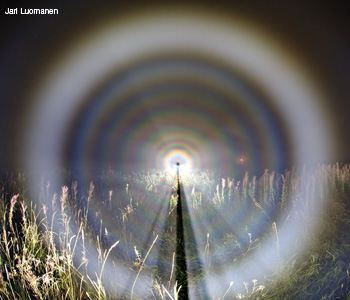Feature
Light and Color in Nature: A Return to Optics’ Roots
Past OSA President Bob Greenler and OSA Fellow Dave Lynch describe a remarkable conference series in which scientists gather to explore beautiful naked-eye phenomena in the world around us.
 As water droplets get smaller, the optical effects they produce become larger. For smaller droplets, the rainbow colors broaden and overlap, producing a white rainbow (or “fogbow”); the interference fringes inside the bow (supernumerary bows) become more widely spaced; and the colored rings around the antisolar point (the glory) expand. All of these effects are produced here by substituting an electric light for the sun. The features in the photo are sharper than those seen with natural phenomena because the angular size of the lamp is less than that of the sun.
As water droplets get smaller, the optical effects they produce become larger. For smaller droplets, the rainbow colors broaden and overlap, producing a white rainbow (or “fogbow”); the interference fringes inside the bow (supernumerary bows) become more widely spaced; and the colored rings around the antisolar point (the glory) expand. All of these effects are produced here by substituting an electric light for the sun. The features in the photo are sharper than those seen with natural phenomena because the angular size of the lamp is less than that of the sun.
Back in the 19th century and earlier—in the days of Rayleigh, Tyndall, Maxwell and Snell—science was often conducted by natural philosophers—generalists whose primary tools were their own eyes. The subjects of their curiosity were everyday phenomena such as the blue sky, white clouds, the flattened horizon sun, haloes and mirages.
…Log in or become a member to view the full text of this article.
This article may be available for purchase via the search at Optica Publishing Group.
Optica Members get the full text of Optics & Photonics News, plus a variety of other member benefits.
